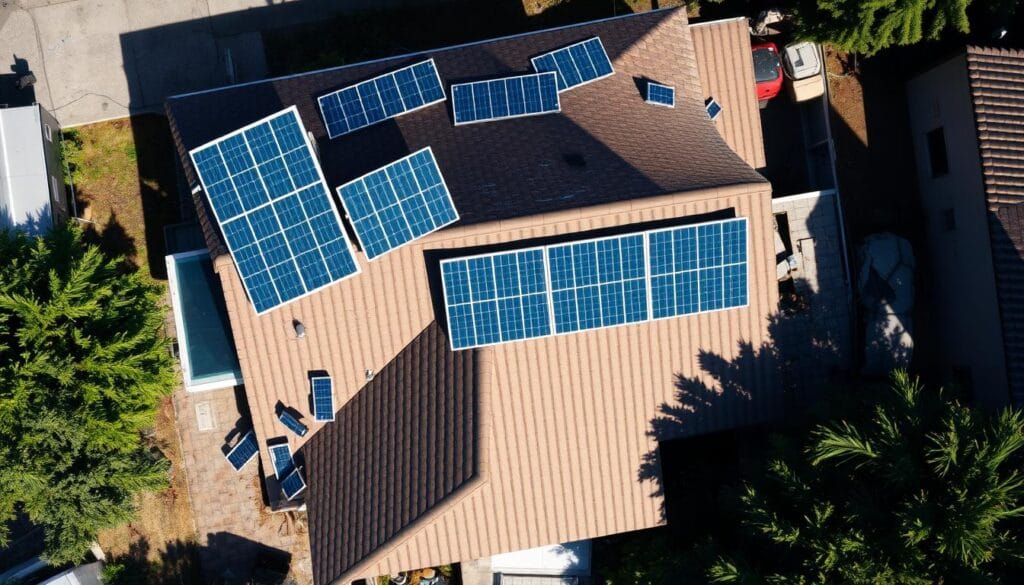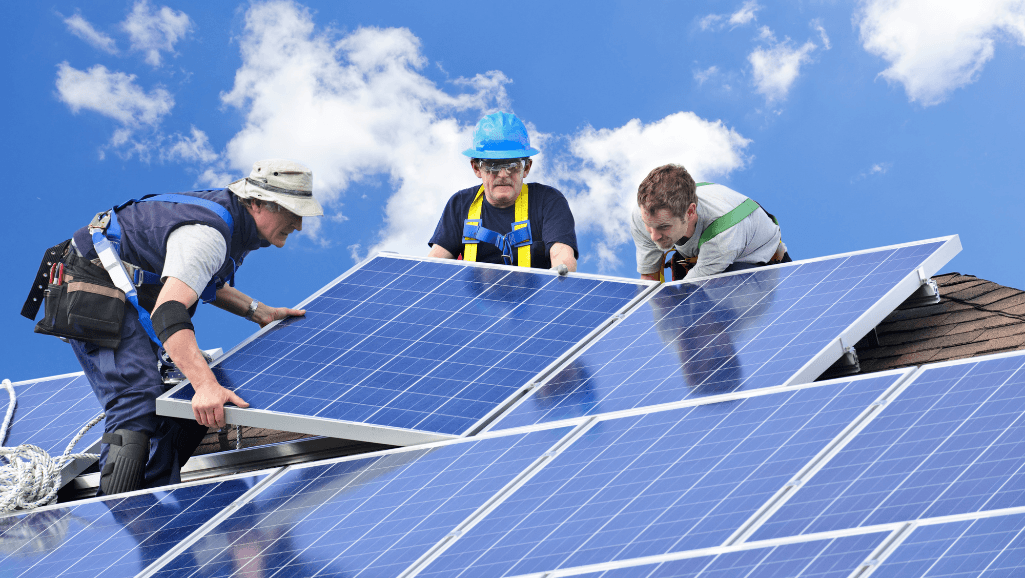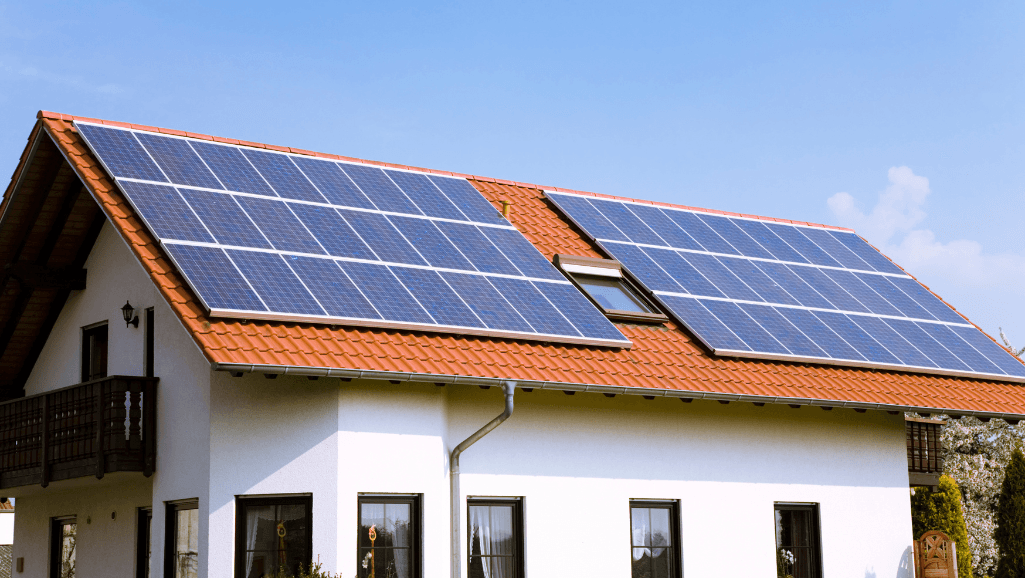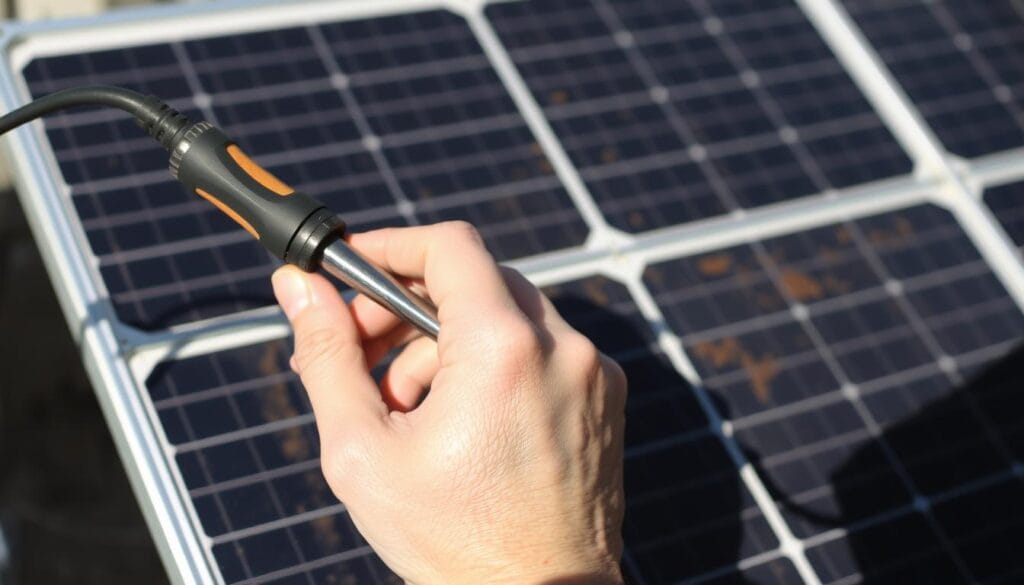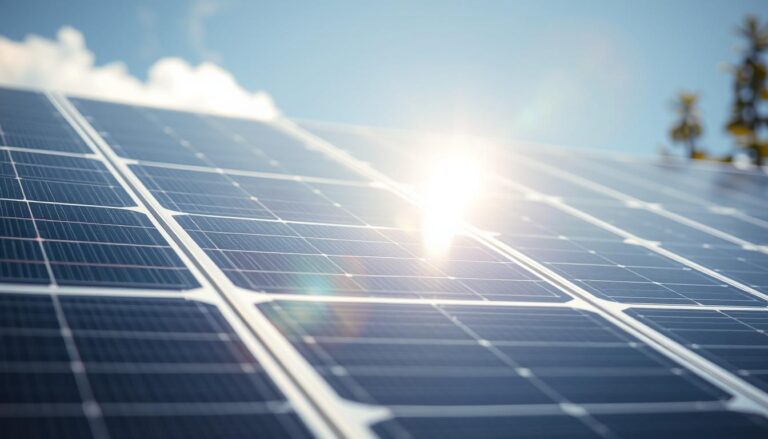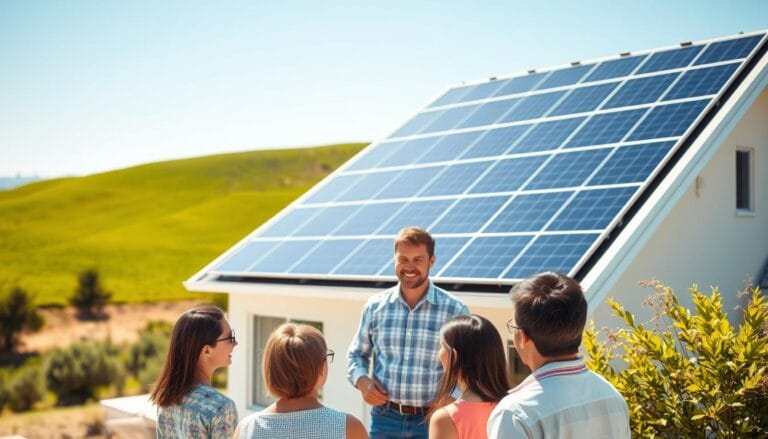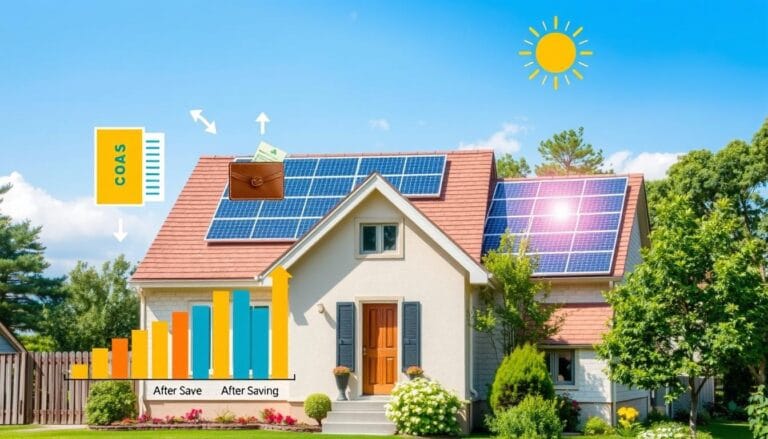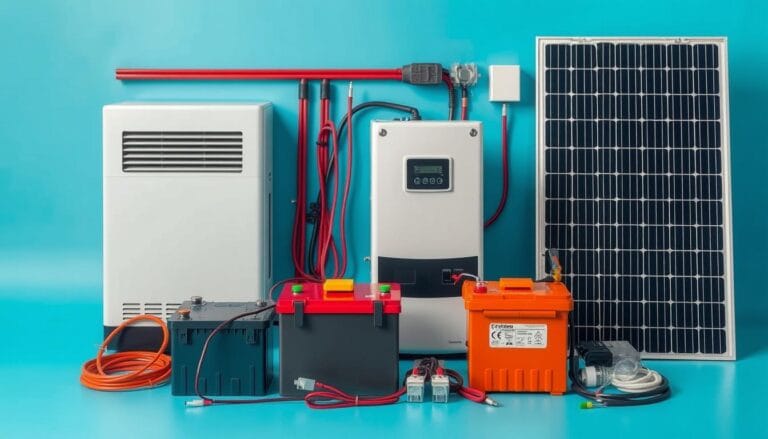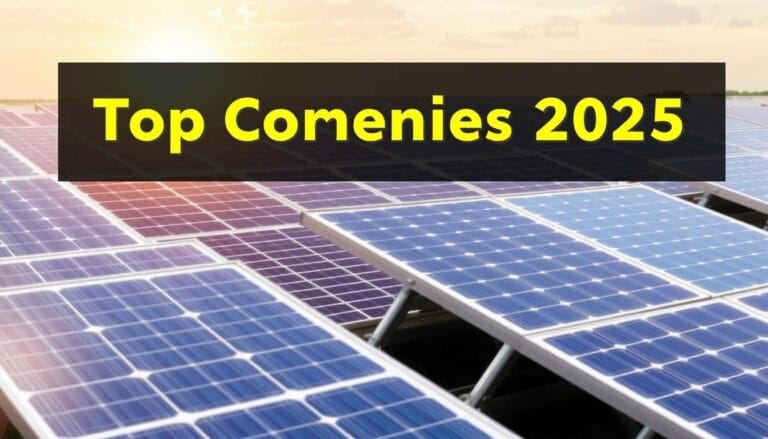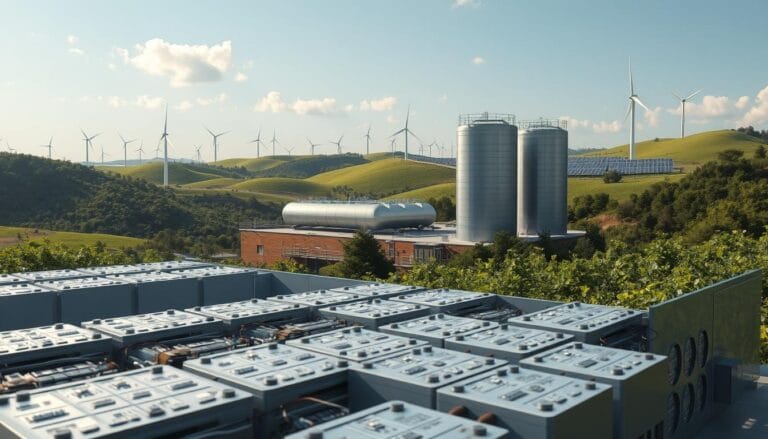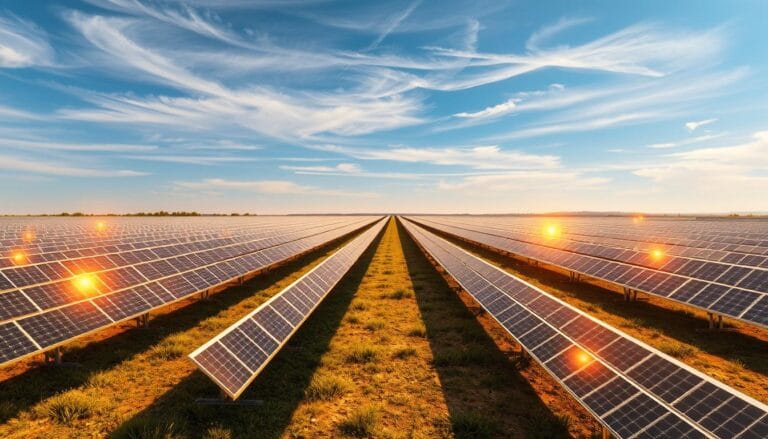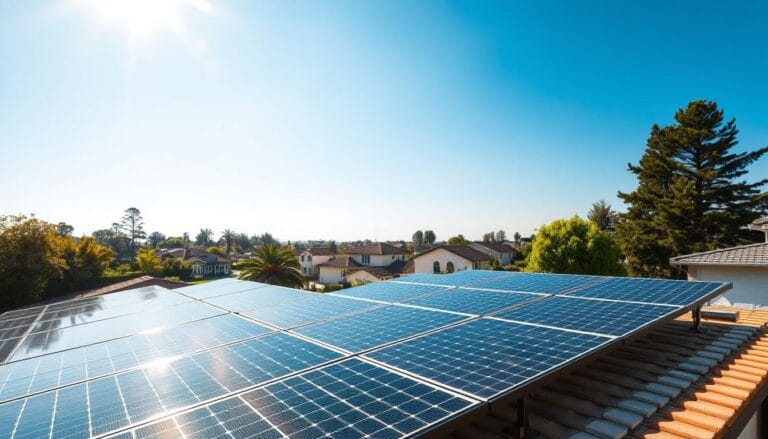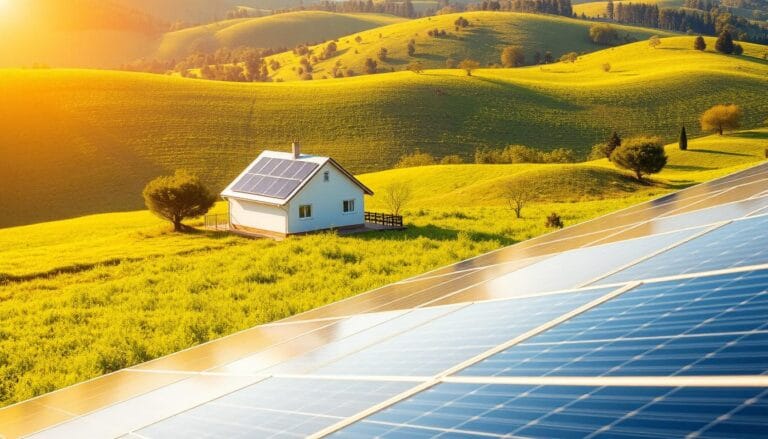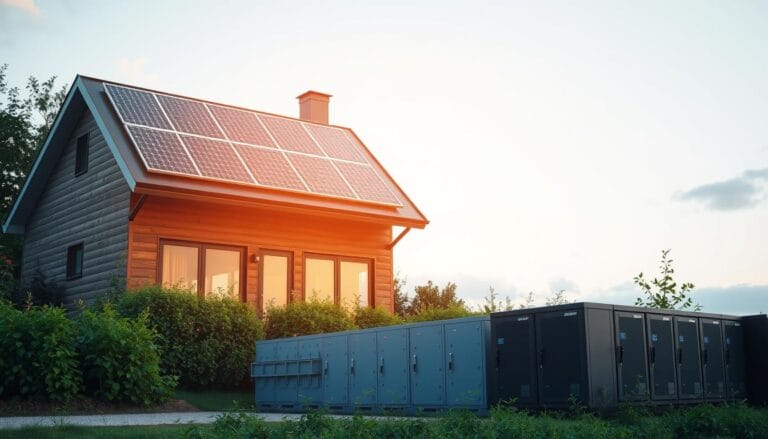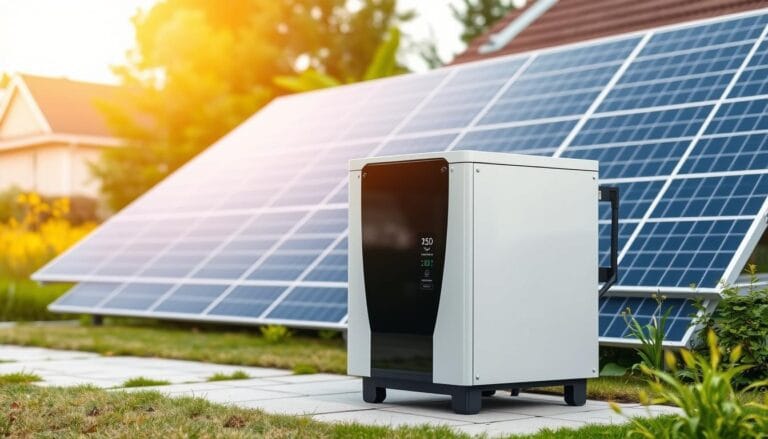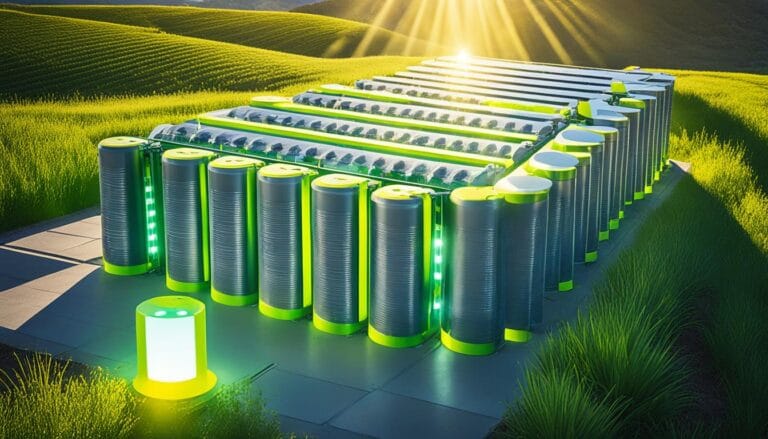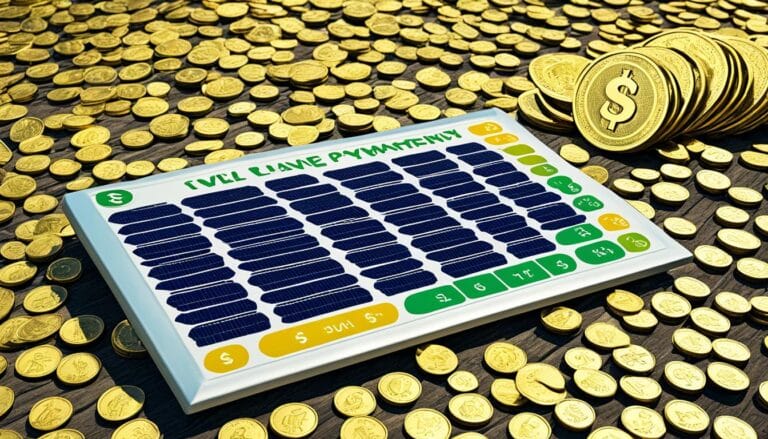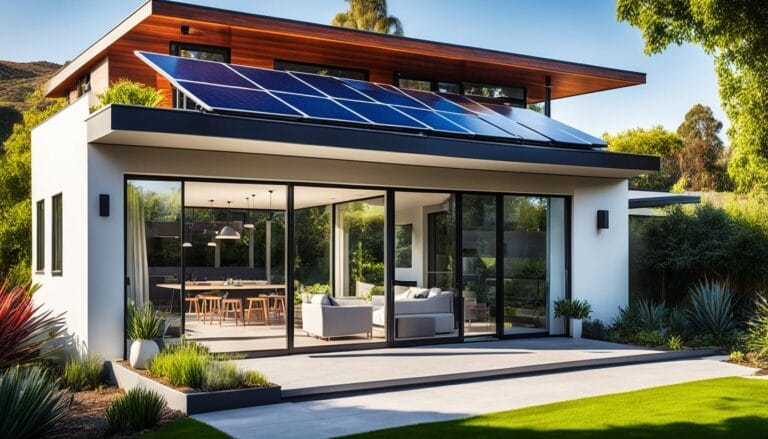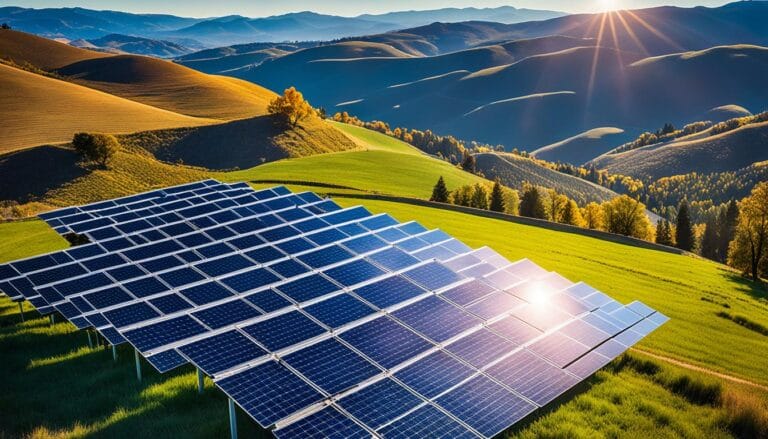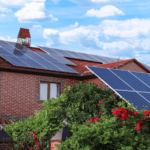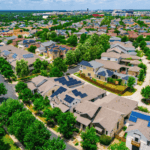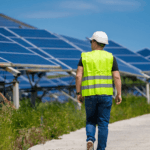Solar panels are great for the planet, but they’re not perfect. They face issues like environmental damage and technical problems. It’s key for homeowners and businesses to know how to fix these problems. This guide will help you keep your solar panels running smoothly.
Key Takeaways
- common solar panel problems.
- Install solar panels in a way that looks good and works well.
- Regular maintenance is a must, including checks and cleaning to avoid problems.
- Learn about how bad weather can affect solar panels and take steps to protect them.
- Know when you need experts for things like inverter issues and electrical problems.
- See the value in solar panels over time, thanks to subsidies and smart upkeep.
- Think about how snow and birds might affect your solar panels and plan accordingly.
Inverter Issues: Navigating Solar Power Conversion
The inverter is the core of a solar power system. It changes DC electricity from solar panels into AC electricity for homes and businesses. Knowing about solar panel repair and inverter problems is key for top performance. It’s important to understand compatibility issues for good solar panel maintenance tips.
One common problem is when solar inverters won’t turn on. This is often because of bad connections. Checking DC and AC connections regularly helps avoid this. Also, not matching inverters with solar panels can cause problems and be dangerous.
It’s crucial to make sure the voltage, power, and current match for solar power systems to work right. Inverters like the APS COMMERCIAL SOLAR INVERTER are very efficient, over 99.5%. They work well with different panel sizes and system designs.
| Issue | Impact | Solution |
|---|---|---|
| Voltage mismatch | Decreased efficiency, potential equipment damage | Ensure strict compatibility between panel and inverter specifications |
| Inverter fails to turn on | System downtime, loss of energy production | Check and secure all electrical connections |
| Error codes on inverter | Indication of underlying faults | Consult manufacturer guidelines or seek professional repair |
| Communication errors | Hindered performance monitoring and system control | Upgrade to compatible monitoring and management systems |
Following solar panel maintenance tips helps extend the inverter’s life and boosts the solar system’s efficiency and safety. Spotting and fixing inverter problems early can save money on solar panel repair and keep the system running well. It’s smart to get help from experts for precise advice on fixing and maintaining your system.
Dealing with a simple reset or complex compatibility issues requires a proactive maintenance approach. With the right understanding and skills, you can greatly improve your solar power system’s performance and lifespan.
Installations and Roof Concerns
When looking at common issues with solar panels, how they are installed and the roof’s condition are key. Getting solar panels on the roof right is important for their work and for keeping the building safe. We’ll look at the main worries with these setups and their effect on roofs.
Microcracks: The Hidden Culprit
Microcracks are a big deal for solar panels, even though they’re small. These tiny cracks can come from extreme temperature changes, mistakes in making the panels, or pressure during setup. If left unchecked, these cracks can get bigger and lower the panel’s power output. Studies say these cracks might mean you need to replace the whole solar panel because fixing them is hard once they affect energy production.
Roof Damage: Assessing the Impact
Putting solar panels on the roof can be hard on the roof itself. The setup needs to go through the roof, which can cause leaks and damage to tiles or shingles. Using top-notch mounting gear and barriers can help, but it has to be done right. Working with trusted installers who use strong materials like Brava Roof Tile can really help avoid rooftop solar panel problems. Checking the roof regularly after setup is also key to stop leaks and keep tiles in place.
Knowing about these issues is key for homeowners and those who install solar systems. By tackling these problems early, solar systems can last longer and work better. This helps with the growing use of solar energy across the country.
Rooftop Solar Panel Problems: Weather and Warranties
Solar panels are tough and can handle many weather conditions, from hot sun to cold. But, extreme weather like strong winds, hail, and lightning can be tough. These can damage panels or cause electrical issues, showing why good solar panel system warranties are key.
To avoid problems, it’s important for homeowners to take good care of their solar panels. Regular checks and professional setups help keep them working well and protect your warranty. Warranties can last up to 25 years, covering defects and performance issues.
But, warranties don’t cover damage from misuse, changes without permission, or big weather events. So, following a maintenance plan is crucial. This includes cleaning every six months and getting experts to check your system. Doing this keeps your panels working longer and helps you use your warranty fully.
| Component | Warranty Duration | Coverage Detail |
|---|---|---|
| Solar Panels | 10-25 years | Covers product faults and performance, not including external damage or improper use. |
| Inverters | 10-25 years | Covers functionality, excluding issues from DIY installations or external damages. |
| Batteries | 5-12 years | Includes service life, typically excludes damage from external sources or improper handling. |
Using solar system monitoring tools is also key. They spot problems early, helping avoid big damage that might not be covered by warranty. If you notice your panels aren’t working right, especially after bad weather, get them checked fast. This can save you money and trouble later.
Keeping in touch with your installer is also important. It helps you report any damage or issues quickly, avoiding problems with warranty claims. With these solar panel maintenance tips, you can keep your solar panels running well, even with the unpredictable weather.
Solar System Troubleshooting: Uncovering the PID Effect
Understanding the challenges of Potential Induced Degradation (PID) is key to keeping solar panels working well. PID happens when voltage differences between the solar module’s frame and cells cause faster wear and tear. This leads to big efficiency losses, making fixing and preventing problems with solar panels crucial.
Things like high humidity and heat make PID worse, showing why it’s important to install panels right and keep them clean. Dust and other dirt can also make things worse, so cleaning and checking solar panels often is a must.
| Factor | Impact on PID | Mitigation Technique |
|---|---|---|
| High Humidity | Increases PID potential | Install in low-humidity areas or use humidity-resistant panels |
| High Temperature | Accelerates degradation rate | Cooling systems or heat-resistant panel technologies |
| Dust and Contaminants | Aggravates PID effects | Regular cleaning and anti-pollution coatings |
| Technological Advancements | Prevents and reduces PID | Anti-PID technology, such as HJT panels and MPPT systems |
| Electrical Grounding | Mitigates potential differences | Ground DC negative terminal or utilize anti-PID boxes |
New solar tech, like Heterojunction with Intrinsic Thin layer (HJT) panels and Maximum Power Point Trackers (MPPT), fights PID well. Companies like Maysun Solar lead in making panels that stand up to degradation, making solar systems more reliable and efficient in tough conditions.
Being proactive with solar panel care and regular checks is key to fixing and keeping solar panels running well. Using new tech and regular upkeep can really cut down the effects of PID on solar systems.
Maintaining System Health: Confronting Hot Spots
Hot spots on solar panels are common and can cause big problems if not fixed quickly. These areas get too hot because of issues with the PV cells or bad wire soldering. It’s important to use solar panel maintenance tips and solar panel repair methods to avoid these issues.
Checking your panels often helps spot hot spots. Micro-cracks from stress or mistakes during making can make these hot areas. Also, keeping solar batteries in good shape is key for your solar system’s health.
| Issue | Cause | Impact | Solution |
|---|---|---|---|
| Hot Spots | Structural Issues, Flawed Wiring | Reduced lifespan, Potential Fires | Regular Inspections, Repair |
| Micro-Cracks | Thermal Stress, Manufacturing Faults | Loss of Efficiency | Preventive Repairs |
| Potential Induced Degradation (PID) | Negative Potential to Earth | Up to 70% Power Loss | High Impedance Grounding |
Shading and dirt are big problems for solar panel maintenance tips. Even a little shade can cut down the panels’ power. Dirt stops the panels from getting enough sunlight. Keeping your panels clean and clear is key.
Using monitoring systems helps a lot with maintenance. These systems watch the panels’ performance and send alerts for problems. This makes solar panel repair easier and quicker.
Fixing these issues early and often is crucial for keeping solar panels working well and safely. It helps protect your investment in green energy.
Financial Considerations: The Cost of Going Solar
Switching to solar energy can seem expensive at first. But, thanks to new policies and technology, solar energy is now more affordable and appealing. Knowing the costs and benefits, along with financial help, can make it easier for homeowners to choose this green energy option.
Investment vs. Return: Understanding the Economics
Installing a solar power system costs between $10,000 and $18,000. You can get a 30% tax credit for it. These systems add value to your home and can return about 10% on your investment, which is as good as other investments. They last 20 to 30 years, saving you money on electricity bills.
With energy prices going up and traditional resources running out by 2052, solar is a smart choice. It’s good for your wallet and the planet.
Subsidies and Incentives: Navigating Financial Aid Options
There are many incentives from the government and local groups to help with the cost of solar. The Inflation Reduction Act has boosted the tax credit for solar to 30%. This covers equipment, installation, and labor costs until 2032. Plus, you can sell extra power back to the grid for more savings.
If you’re worried about the upfront cost, there are financing options. You can buy solar panels outright, lease them, or use a Power Purchase Agreement (PPA). Home equity loans are also an option. Each choice affects how affordable a solar system is for you, based on your finances and energy needs.
Common Solar Panel Problems
As solar technology grows, knowing about common issues with solar panels is key. This section looks at typical problems with solar panels. It focuses on battery and electrical issues and offers tips for troubleshooting solar panels.
Battery Issues: Balancing Charge and Care
Solar systems with batteries face problems like overcharging or undercharging. These solar panel system faults can hurt battery life and performance. To fix these issues, batteries must be installed and maintained right. Regular checks for damage are a must to keep the battery working well. Here are some ways to prevent and fix battery problems:
- Regular inspection to spot early signs of damage.
- Make sure charging is regulated to avoid overcharging or deep discharge.
- Keep the battery in a cool place to protect it from damage.
Electrical Integrity: Ensuring Safe Connections
Electrical problems, like loose connections or broken wiring, can cause power loss or even fires. These are common issues with solar panels that need watching. Getting a professional to install and maintain your is crucial. Regular checks can spot and fix these problems quickly, keeping your system safe and working right. Here’s how to keep your electrical system in good shape:
- Have a yearly check by a certified pro to test and secure electrical connections.
- Use strong, long-lasting wiring and parts to lower the chance of problems.
- Fix any corrosion or wear you find during regular checks right away.
| Issue | Signs | Solutions |
|---|---|---|
| Battery Overcharging | Swelling, heat generation | Install regulation systems |
| Loose Connections | Intermittent power, sparking | Tighten connections, regular checks |
| Wire Corrosion | Discolored wires, poor performance | Replace wires, use corrosion-resistant materials |
| Undercharging | Low output, slow charging | Adjust charger settings, check for panel shading |
Fixing these key areas helps improve your solar panel’s performance and safety. By following these tips, homeowners and businesses can reduce risks with their solar panels.
Sustainability and Disposal: The Recycling Dilemma
As solar energy grows, sustainability issues with recycling solar panels become more important. Even though everyone agrees we need to solar panel recycle, there are big challenges. Looking at recycling economics shows us a complex situation.
By 2050, we’ll have 78 million tons of solar panel waste. But, only about 10% of old solar panels are recycled in the U.S. This shows we’re not doing well on sustainability. The European Union, however, requires companies to recycle at least 80% of solar panel waste. This shows their strong commitment to the environment.
- High Recovery Rates for Materials: Experts have successfully reclaimed over 90% of semiconductor materials and glass from solar panels, underscoring the potential for efficient resource utilization.
- Cost Considerations: The price to recycle a single 300-watt panel in the U.S. fluctuates between $15 and $45, yet disposal in a landfill may cost as little as $1 to $5. This stark difference highlights economic disincentives that could hinder recycling efforts without policy interventions.
New ways to solar panel recycle are key. For example, a lab process got 95% of silver from old panels with 99.9% purity. This could change recycling economics, making it cheaper.
Big investments in recycling are happening worldwide. Tialpi in Italy and Veolia in France are setting up big facilities to handle thousands of tons of solar panels each year. This shows we can scale up solar panel recycle efforts.
Looking at solar technology costs helps us understand more about recycling. As solar power becomes a big part of the world’s electricity, recycling is key to reducing harm to the environment.
| Year | Global Solar Capacity (GW) | Estimated Panel Waste by 2050 (million tons) |
|---|---|---|
| 2000 | 1.4 | Data Not Available |
| 2020 | 760 | Data Not Available |
| 2050 (Projection) | 4,500 | 80 |
As we move towards sustainability, we must focus more on solar panel recycle efforts worldwide. This will help us enjoy the benefits of solar power without harming our planet.
Electrical Challenges: Diagnosing and Correcting Issues
Fixing common solar panel problems needs a careful approach, especially with electrical issues. These problems often show deeper system issues. From loose wiring to faulty inverters, they highlight the complex nature of how to fix solar panel problems.
To keep your solar panels working well and lasting long, here are some common issues and how to fix them:
- Loose wiring is a common electrical problem that can lower efficiency and pose safety risks. It should be fixed quickly, best done by a professional to ensure it’s done right.
- Dirt, dust, and pollen can reduce efficiency by about 5% each year. Cleaning them regularly is key, especially in dusty places.
- High temperatures can harm solar panels. Choosing panels like Panasonic HIT can help them work better in hot weather.
- Cracks in PV cells can slowly reduce performance and might mean you need to replace the panel.
Understanding and using diagnostic tools and performance data is key to good maintenance and troubleshooting. Apps that track solar output and error messages from the inverter help understand the system’s health. A steady green light means the inverter is working well, but a tripped breaker could mean an overload and needs a pro to check.
| Issue | Impact on Performance | Suggested Action |
|---|---|---|
| Loose Wiring | Can lead to operational hazards and inefficiencies | Inspect and secure by certified technicians |
| High Temperatures | Leads to heat fade, reducing output in peak conditions | Install high-temperature tolerant panels like Panasonic HIT |
| Dirt and Debris | Decreases output significantly | Regular cleaning schedule, more frequent in dusty areas |
| Physical Panel Damage | Gradual loss in efficiency, might require replacement | Maintain and inspect regularly; replace if necessary |
Fixing how to fix solar panel problems is more than just simple repairs. It involves thorough checks, regular upkeep, and working with experts like Green Air Heating and Air Conditioning, Inc. They’re known for their skill in high-efficiency solar solutions. This careful approach helps keep your solar panels running well and saves on energy costs, making solar technology a smart long-term choice.
Solar Panel Performance: Efficiency and Aesthetics
Improving solar panels means fixing common problems and making them look good in homes and cities. It’s key to know how to keep solar panels working well and looking good. This keeps solar technology useful and pleasing to the eye.
Optimizing Energy Conversion
Solar panels can lose efficiency due to shade, dirt, or bad installation angles. Following strict maintenance tips helps them work better. New tech like solar trackers keeps panels facing the sun all day, boosting energy capture.
Models like Panasonic HIT work well in hot weather, a big challenge in many places.
Integrating Solar Aesthetically into Home Design
Making solar panels look good is important for people to accept them. Homeowners balance the look of solar panels with energy savings and environmental gains. Using smart placement and products like stylish panel skins or hidden solar tiles helps solar setups fit in with a home’s look.
| Panel Type | Cost | Design Appeal | Efficiency |
|---|---|---|---|
| Silver Frame | Most cost-effective | Utility-focused design | Standard |
| Black Frame | Moderately higher | Sleeker look | Improved |
| Black on White Frame | Potentially lower installation costs | Versatile and modern | High |
| Black on Black (Standard) | Higher due to design | Modern, less visually intrusive | Slightly lower due to heat retention |
| Advanced Black on Black (SunPower) | Higher | Sleek, tinted window appearance | Industry-standard |
| Solar Tiles | Higher initial investment | Seamlessly blends with roofing | Varied based on installation |
New tech is making solar panels almost invisible. Things like clear solar panels and solar windows are changing the game. They let solar energy fit into city life without losing style. This is key for a green future that looks good.
Conclusion
Maintaining a solar panel system comes with its share of challenges. From inverter malfunctions to recycling issues, there’s a lot to consider. Troubleshooting solar panels means fixing various problems, like snail trails that block light or the PID effect that lowers power output. It’s key to get professional help and follow solar panel maintenance tips to keep your system running well.
Looking at the stats, it’s clear that staying proactive is crucial for a solar system to work well. Getting help from experts is vital, as mistakes can damage your roof or cause hot spots. It’s important to check your panels every few years to spot small cracks, avoid battery overcharging, and keep your solar setup safe.
Switching to solar power is a big step towards sustainability. But, it’s not just about flipping a switch. Success with solar panels means keeping an eye on them, doing regular maintenance, and knowing how to handle recycling issues. By tackling these challenges with the right approach, everyone can enjoy the perks of clean energy with confidence and pride.



